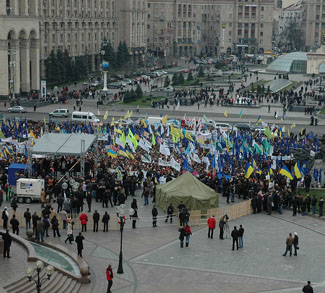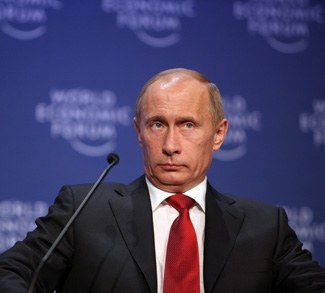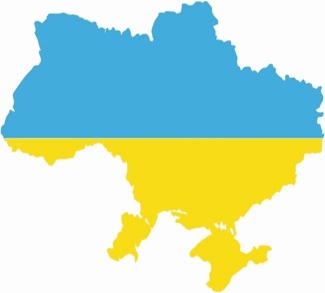Ukrainian lands are located at the gates of Europe and since ancient times foes have been threatening its inhabitants, not all but most of the times from the East. However, the very first statehood was brought to Kyiv from the North, by means of rivers and Vikings, and over the 10th and 11th centuries it was the largest and the most powerful state in Europe. Between the late 14th century and 1991, Ukrainians had their independent state twice, but for more than three hundred years most of Ukraine was under Moscovian imperial yoke. Discussing Ukraine in a colonial context, Ukrainian historian Yaroslav Hrytsak joked that “Ukrainians started as the Scots of the Russian empire but finished as the Irish.” But in this case, even the name for Russian empire was appropriated from the Kyivan heritage.
The Ukrainian lands and people have been an integral part of European politics and values for more than thousand years, serving as the gates of Europe, albeit most of that time besieged or occupied by invaders from the East, to the detrimental effect of the regional security.
Ukrainians-Cossacks
The inhabitants of Ukraine, who are all at present called Cossacks, and glory in carrying that name, are of a good stature, active, strong, and dexterous in what they do, liberal, and little caring to gather riches, great lovers of liberty, and that cannot suffer any yoke; unwearied, bold and brave…

Figure 1
This is a passage from the first extensive account about Ukraine and Cossacks in the English language, translated from a book written by French officer Pierre Chevalier, who was commandeered to Ukraine in the 1640-50s (Figure 1).
“The name Cossacks was given them by reason of their address and agility in penetrating even the most difficult and dangerous places […] whereby they made war […]. Cosa signifying […] a goat” in Ukrainian and Polish, as until 1648 all Ukrainians were subjects of the Polish-Lithuanian state.
A Discourse of the Original, Contrey, Manners, Government and Religion of the Cossacks […] was accompanied by the 1648 map of Ukraine by French fortifications architect Guillaume de Beauplan, commissioned by Poland (Figure 2). Its title reads Ukraina which is Ukraine in Polish and Romanized Ukrainian Україна). The South on this map is placed at the top, where part of the Black Sea is visible and from where Crimean Tatars and Turks regularly raided Ukrainian lands. The East is on the left, where Ukraine’s eastern neighbor was recorded as the Dutchy of Moscoviae. At the same time, the toponym Russiae ([Rus’ia], or how it is pronounced in English today [Rʌʃə]) is present near the right edge in the Western region of Ukraine, next to the city of Lviv (Lwow in Polish).
Before tracing the history of the above-mentioned toponyms, to understand the values and traditions of modern Ukraine better, it is important to learn more about the Ukrainian Cossacks.
Back in the 17th century Ukrainian Cossacks held great military fame across the whole of Europe. They helped the French to capture Dunkirk from Spaniards in 1646; together with Poles, Ukrainians broke into Moscow earlier in 1618 and helped defend Vienna from Turks in 1683; while countless agile sea campaigns to Istanbul traced roots back to the times of Vikings and their raids of Constantinople.

Figure 2: The 1648 map of Ukraine by G. Beauplan.
However, Ukrainian Cossacks of the 15-17th centuries were (and continue to be today) primarily the defenders of Ukrainian lands and freedoms. Politically, Ukrainian Cossacks had very strong democratic traditions. The Polish-Lithuanian Commonwealth that they were a part of had a very powerful parliament and entrenched rights of the gentry, with separate and co-existing Polish and Lithuanian legal and administrative systems – effectively a federation with a king. Ethnic and religious distinctions, but more importantly the hard power Ukrainians held, made their case for the same rights and liberties as those of Poles and Lithuanians. Unable to resolve it, Ukrainians, eventually, launched a war in 1648 in pursuit of becoming equal and self-governing partners in that federation, but ended up forming their own state known as the Cossack Hetmanate.
Unlucky with military allies, Ukrainians made the menacing mistake of trusting authoritarian Moscovia and its Tsar. The infamous 1654 Treaty of Pereiaslav was intentionally dualistic – while Ukrainians were seeking only a military protectorate with independent foreign policy, Moscovian design was an absorption of Ukraine and its army. A decade from then Ukraine was split between Muscovy and Poland.
Ukraine-Rus’
The first Medieval Kyivan state was formed in the 9th century after the arrival of Vikings who became the land’s military and political elites, assimilating into the local East Slavic population over the next couple of centuries. The name Rus’ was brought by them from Sweden, while the city of Kyiv had been already there since the 5th century. Christianization, as Viking’s typical geopolitical move, happened at the end of the 10th century in the Byzantium Orthodoxy.
The map in Figure 3 depicts Kyivan Rus’ territories by the end of the rule of Prince Yaroslav the Wise in 1054, overlaying the borders of the present-day countries in the region. The state was gradually colonizing lands to its northeast, scarcely populated by Finnic tribes. The trident on the coin minted at that time closely resembles the one on the Coat of Arms of modern Ukraine. Interestingly, in the Kyivan Chronicles of the following century, lands far away from each other in the West and in the East started being referred to under the same name Ukraina in references to 1187 and 1189.
Yaroslav’s overriding legacies were the written law codex of the Kyivan state and also unfortunately the absence of any stable system of power succession. As a result, Kyivan Rus’ started disintegrating into warring principalities even before the 13th century’s devasting invasion of the Mongols (the Golden Horde) from the East.

Figure 3 : Kyivan Rus’ in 980-1054, the map is a modern reproduction based on historical maps
In Figure 4, the last-standing Principality of Galicia-Volhynia is shown. In diplomatic efforts to forge an anti-Mongol coalition, Prince Danylo (Daniel in English) sought allies among the Catholic states, near and far, and in 1253 was coronated as the King by the papal legate. For the preceding decade, he managed to hold Kyiv, and in the West, his lands were still referred to as Rus’ or in Latin – Rusiae or Ruthenia. The state became known as the Kingdom of Ruthenia, which lasted till the middle of the 14th century and perished not least due to the absence of a direct heir.

Figure 4: The map of Galicia-Volhynia in the 13-14th centuries, author of the reproduction is unknown, based on historic map in Крип’якевич І.П., Галицько-Волинське князівство (Kyiv: 1984)
After the disintegration of Kyivan Rus’, the rising power of pagan Lithuania gradually took most of the Kyivan lands from Mongols over the 14-15th centuries, including the territories of the Kingdom of Ruthenia split with Poland earlier in the 14th century (Figure 5).
“As Lithuanian military power flowed south, to Kyiv, so the civilization of Rus’ – Orthodox religion, Church Slavonic language, mature legal traditions – flowed north to Vilnius”, writes Timothy Snyder in his book Reconstruction of Nations about the origins and development of Polish, Ukrainian, Lithuanian and Belarusian nations. Lithuania adopted the Kyivan legal system and accepted the religion of its people, who hardly viewed new rulers as occupiers, but instead, with most of the usual elites perished, as liberators and an acceptable administration.
Tracing the roots of languages, Snyder concludes that vernacular Ruthenian became the Ukrainian language.
Insightful from this period are names and titles in documents and treaties. For example, in the year 1385 of the original union with Poland, Snyder writes, a Lithuanian ruler was named “The Grand Duke of Lithuania and Lord and heir of Rus’” same as the King of the newly reformed Polish-Lithuanian Commonwealth in 1569 (when the administration of Ukrainian lands was transferred from Lithuania to Poland), and “[i]n a 1449 treaty between Poland-Lithuania and Muscovy, the former was called Rusian, and the latter – Muscovite.”

Figure 5: Grand Dutchy of Lithuania (1368-1434), modern reproduction, based on historical maps of Ukraine.
Modern Ukraine Against All Odds
In the 18th century, Muscovy appropriated the name Rus’ and renamed itself the Russian Empire. Together with Prussia and Austria, they partitioned Poland three times, after which Austria got Galicia (with Lviv region in it) in the West, while Muscovites grabbed the rest of Ukraine.
The Cossack host in Ukraine was disbanded, and many Cossacks were removed to Kuban, the region between Crimea and Caucasus. Several of them over generations became russian казаки [kʌ-zaks], known in Australia from recent meddling of the Sydney-based Aussie Cossack and in New Zealand from the 1970s’ Dancing Cossacks political TV commercial. Ukrainian козаки [kɔ́-zaks] settled further south to the shores of the Black Sea, many as peasants. English language, unfortunately, does not distinguish between the two.
Defeating Turkey in war, the Muscovites conquered Crimea and forced its Tatar population to leave their homes either to the peninsula’s mountains or to flee abroad. Two-thirds of the indigenous population chose a dangerous journey to Turkey instead of a Russian yoke. Muscovites happily started moving into the cleansed lands and houses, founding the false myth of Crimea being historically Russian.
In the 19th century, the Tsar lured Western entrepreneurs, who brought specialists and capital with them, into the southeastern lands of Ukraine kicking off the industrialization of the region. In mushrooming towns, factories needed manual labor, and while Ukrainians were traditionally fond of harvesting their fertile lands, Muscovites from less-productive northeastern lands moved in and made their language dominant in urban societies of the region.
To absorb Ukraine, Muscovites needed to erase Ukrainian national identity, and so they started linguicide or language genocide. The Ukrainian language was banned in schools and institutions; printing books in Ukrainian was forbidden, and participants in cultural and civic events held in the Ukrainian language were prosecuted. As a result, most of the Ukrainian intelligentsia emigrated to Lviv in Galicia, where Austria was supportive of the Ukrainian national identity.
In the final years of the First World War, the independent Ukrainian People’s Republic was declared in Kyiv in 1917, soon merging with Western Ukraine. However, weakened by varying political visions among its competing leaders, lack of a well-organized army, and committed allies, but primarily because of the invasion of Moscovites-Bolsheviks, independence was short-lived. In 1922 Ukraine was partitioned: Galicia and Volhynia became part of the restored Polish state until 1939, when it was invaded by Moscow and annexed to the rest of Ukraine, together imprisoned in the empire renamed as the Soviet Union.
In 1920 in Vienna, a map was published showing the presence of Ukrainians around the world (Figure 6). Easy to notice much wider areas where Ukrainians constituted the majority of the population beyond the present-day borders. Everything red to the East of the core Ukrainian lands is the outcome of the resettlements of Ukrainians in the Russian Empire. The 1926 Soviet Census reported eight million Ukrainians (or 25 per cent) outside of the defined borders of the Ukrainian Soviet Republic, primarily in the Kuban, the Far East, and Siberia.

Figure 6: Part of the world map with the placement of Ukrainians in the world, 1920
By 1941 around 1.3mln more Ukrainians were deported, most of whom – to the labor camps. Throughout the Second World War, some eight million Ukrainians were killed at the front or murdered. In 1944 the whole remaining population of Crimean Tatars was deported. Across 1944-51 approximately 750,000 more well-off Western Ukraine peasants were evicted and deported.
However, the darkest year for Ukrainians was 1933, the year of unabating hunger orchestrated by Moscow or man-made famine known in Ukraine as Holodomor. The map in Figure 7 shows the difference in the population between the 1929 and 1933 censuses. The darkest color means more than 25 per cent of people vanished in between. And Figure 6 already informed us that those areas were populated predominantly by Ukrainians.

Figure 7: Map of the regions with the highest rate of population decline over 1929-33, based on the statistics from “The Foreign Office and the famine : British documents on Ukraine and the Great Famine of 1932-1933”
Historian Anne Applebaum concludes in her Red Famine: Stalin’s War on Ukraine that through unrealistic harvesting targets, confiscations, a ban on keeping any grain for households, even destroying millstones if found, and a ban on leaving areas of residence, Moscow “deliberately set out to kill” around six million people, predominantly Ukrainians.
This historical act of deliberate mass murder based on ethnical identity has long been recognized as a genocide against the Ukrainian people, and by three dozen countries and the European Parliament. Unfortunately, New Zealand still stands out from its traditional allies and like-minded democracies in this question.
Despite continued lingual Russification and Sovietization of society, in 1991 people across all regions of Ukraine, voted at the referendum by the total majority of 92 per cent (including the lowest in Crimea of 54%) for independence, and regained it. Over the 1990s, Ukrainian political leadership, under pressure from the West, gave up the world’s third-largest nuclear arsenal it possessed, for assurances of the security and integrity of its borders within the framework of the Budapest Memorandum. From Moscow’s perspective, it was yet another international document it signed but dumped not long after. On several occasions, such as the 2004 Orange Revolution and 2013-14 Revolution of Dignity, Ukrainians made it abundantly clear that they have had enough of Muscovites meddling in their lives and history, and don’t want to be a so-called “Russian backyard.”
Ukrainians have a unique, centuries-long history of statehood, traditions, language, and identity. Muscovites, however, arrogantly claim part of the Kyivan heritage to themselves. But rewriting history does not make any appropriation legal, even centuries after the original grab, similarly as concealment and denial of past and present crimes, do not wash them away. Ukrainian lands and people have been part of European culture and politics for thousands of years, while destructive and blood-thirsty hordes have been invading it from the East for more than millennia, all in vain attempts to exterminate and rob the people of Ukraine. As long as Ukraine stands independent and strong, Europe is secure.
The views expressed in this article belong to the author(s) alone and do not necessarily reflect those of Geopoliticalmonitor.com.




